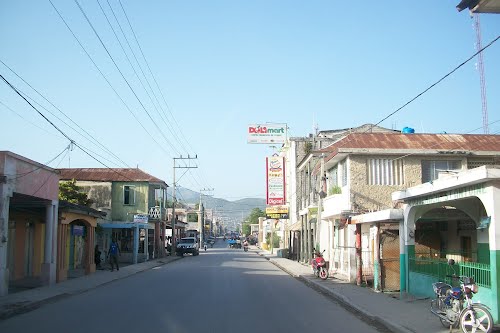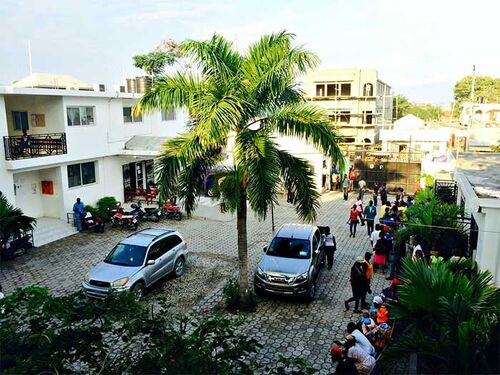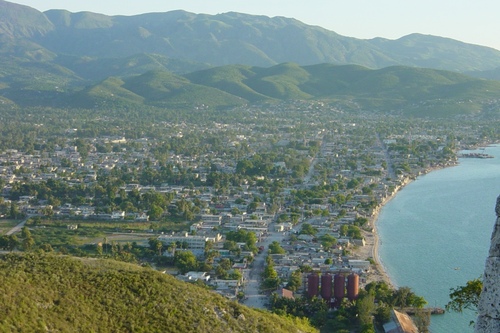"Se gou bouyon ki mete lang deyò';'" It is the taste of the broth that makes the tongue stick out.
Meaning : "Good food leads to good conversations."
-Haitian Proverb
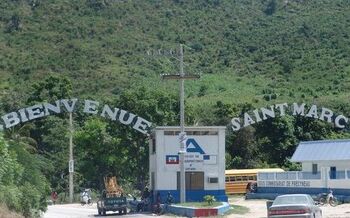
Welcome sign

Location in Haiti


Location in upstate Haiti, on Route Nationale 1
Saint-Marc (Kreyol: Sen Mak; English: Saint Mark) is the seventh-most populous city in Haiti and the second-most populous city in the Artibonite Department, with 266,642 residents in 2015.
Settled as a French farming community in 1695, it was founded in 1716 and later grew to become a center of trade, shipbuilding, and agriculture. The town incorporated to subsidize the Compagnie Nationale, the National Railroad, and rapidly industrialized following the rail line's connection to Port-au-Prince and Verrettes. It is one of the oldest municipalites in the country, having celebrated its 300th anniversary on April 25, 2016.
The city of Saint-Marc serves as the seat of Saint-Marc Arrondissement, which had a population of 443,007 based on the 2015 census estimates, making it the 5th largest borough in Haiti.
Straddling the regional divide between Northern and Central Haiti, Saint-Marc anchors the dynamic coastal area of a great fertile flatland known as the Artibonite Plain. The city is located just a few miles north of what is considered the most attractive part of the country, the Arcadian Coast, dotted with hotels, seaside resorts, and historical monuments. Downtown Saint-Marc and Downtown Gonaives are approximately 56 km (35 miles) apart, both falling along the Route Nationale 1 corridor.
Saint-Marc was named by a dedication in the 16th-century (1500s) for the construction of the Saint-Marc Chapel, whose feast day is April 25. The city is located on the site of an old Indian village which, in the fifteenth century (1400s), was at the northern limit of the ancient Taino kindgom of Xaragua. Many historical facts have marked this town. In March 1790, the city of Saint-Marc welcomed the 212 members of the colonial assembly called the Assembly of Saint-Marc, chaired by the Baron de la Chevalerie. During the War of Independence, Saint-Marc was one of the regions in rebellion against the French colonists. In February 1802, French troops landed under the orders of General Boudet; when the Leclerc expedition arrived, General Dessalines ordered the town of Saint-Marc to be set on fire.
The commune of Saint-Marc is one of the most historically-rich regions of the Artibonite Department. It contains many natural wonders, including the Gode River Falls and Grotte de la Voûte; military architecture and civil society represented by fortifications such as Belair and Diamant. Other notable attractions include the Grosse Roche and Amani-y Beaches and the waterfalls on the Tapion River in Deschapelle. Commercial entertainment includes nightclubs and beach resorts. The city is also home to several public parks including Place Cite Nissage Saget and Place Philippe Guerrier. These parks are often surrounded by vendors with carts full of goods.
The city of Saint-Marc is generally considered a safe place to live. About 60% of the population lives in communal sections (within city limits, but outside of the city center).
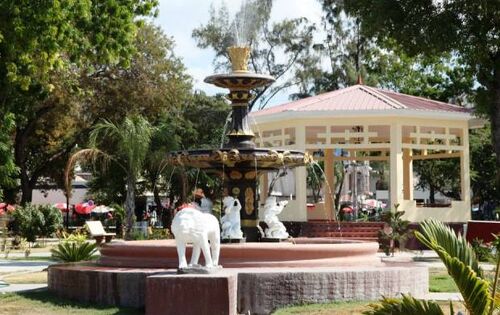
Place Philippe Guerrier; Saint-Marc, Haiti
Overview[]
Nickmame:
"Cité de Nissage Saget"
St. Marc is a large port town surrounded by mountains. At all times, there are many boats in the port, typically sail boats. It is located on flat land close to the sea but its edges extend into the foothills. From these vantage points, the ocean is sometimes viewable. The city has had a glorious past, as evidenced by its role played in the Battle of Savannah in 1774 by sending troops made up of settlers and slaves. It is divided into large districts, namely the City Center (the main commercial area), Pivert, La Scierie, Ti Bois, Portail Montrouis, Portail Guepe, and the new districts that emerged in the 21st century such as Fleurenceau, Blockauss, Pont Tambour, and Freycineau.
Origins[]
Some historians report that during his trip towards the island of Hispaniola, the French naturalist De Vries, surprised by a storm in the wind channel, in front of Borgne, dropped anchor in a bay still unexplored. After being repaired, the ship resumed its journey and arrived at its destination. Little after a while, the sailors returned to this bay which had raised their admiration by its safety, its beauty and fertility. They laid the groundwork for a permanent settlement placed under the invocation of Mark the Evangelist in memory of their discovery of this bay on April 25, 1695.
Other historians say that in 1695 French pirates of Dieppe (at the return of looting of Jamaica) settled in St-Marc under the conduct of a governor named Ducasse and undertook to build sedentary residences there. As buccaneers, they used the salt produced at the mouth of the Haïbonico River. One of his adventurers, Point du Sable, gave birth to that who later founded, in the United States of America, the city of Chicago, the famous Jean Baptiste Pointe de Sable.
History[]

At the time of European encounter, the Taino people lived in a village near the Artibonite Valley's coastal area. They called the vicinity Amani-y, possibly meaning "peace from above". In 1720, a group of French explorers and missionaries came upon the settlement and later erected a chapel on April 25, the feast day of Saint Mark the Evangelist. They named the place "Saint-Marc" in his honor.
| Historical affiliations | |
|---|---|
| Ancient kingdoms of Hispaniola |
Early historic era – 1493 |
| Santo-Domingo |
1493–1625 |
| Saint-Domingue |
1625–1804 |
| First Empire of Haiti |
1804-1806 |
| State of Haiti |
1806-1811 |
| Kingdom of Haiti |
1811-1820 |
| Republic of Spanish Haiti |
1821-1822 |
| Republic of Haiti |
1820-1849 |
| Second Empire of Haiti |
1849-1859 |
| Secnod Haitian Republic |
1859-1957 |
| Duvalier Dynasty |
1957-1986 |
| Third Haitian Republic
|
1986- |
First half of the 18th century
Wealthy planters of France were established in Saint-Marc; they devoted themselves to trade "in righteousness" before touching later on the slave trade, generating enormous profits. The first to settle there were the representatives of the Grou family from Nantes in 1720. The current Haut de Saint-Marc region, known by the official name of Lalouère (4th section), is a territory which has been highlighted and developed by people from the Nantes region, in other words from the Pays de la Loire region and the Loire-Atlantique department. The settlers, transplanted to the new setting of Saint-Marc and finding striking resemblances to their native Loire, then called it "La Loire" (the Loire) which became much later "Lalouère". The city of Saint-Marc, hardly founded, also saw descending on it a significant number of explorers and merchants and representatives of the large houses in Le Havre. In 1748, the Foache House, established in Le Havre, under the corporate name Veuve Foache et Fils, established a family trading post in Saint-Marc . This establishment was located on rue Dauphine, not far from Fort Bergerac (Bégirac) which unfortunately did not resist the onslaught of time. Rue Dauphine has now become Rue Nissage Saget. A Rochelais, by the name of Aimé-Benjamin Fleuriau, who arrived in Saint-Domingue in 1729, largely contributed to the development of trade in Saint-Marc by taking advantage of its port and administrative facilities. He owned plantations at Croix des Bouquets, Arcahaie, and Montrouis and his activities, according to Jacques de Cauna, provided him with an average annual income of 100,000 pounds ($125,000 USD; equal to ~$8 million in todays dollars), considerable for the time. In 1755, Aimé-Benjamin Fleuriau sold his Montrouis habitations to Jean-Pasquet de Lugé, another great settler of his state whose name will remain henceforth attached to this locality located a few kilometers south of the City of Saint-Marc and since called Délugé.
Second half of the 18th century
The beginning of this period greets a city in full expansion from all points of view. Port activity continues to grow with the volume of maritime traffic. Thus France, on the recommendation of its colonial administration, instituted a post of Treasurer of the Navy at Saint-Marc. According to Moreau de Saint-Méry, taken up by Françoise Thésée, the business potential of the parish of Saint-Marc amounted to approximately 693 registered habitations including 16 sugar refineries, 420 indigo factories, 114 cotton factories and 143 coffee plantations, while for Gonaives the figures were 3 sugar factories, 135 indigo factories, 15 cotton factories and 50 coffee plantations. It should be noted that 90% of all the production of the Artibonite (known at that time under the name district of Saint-Marc) destined for export, passed through the port of Saint-Marc. Conversely, almost all of the zone's needs from overseas also took the same route. The other important sectors of activity were added to the list of establishments: numerous distilleries and various types of mills and forges. Along with trade and business, there was also an interest in leisure; painting, singing, classical dances, and especially music. Everywhere, the taste for elegance and refinement seized the settler. Saint-Marcoise society was madly intoxicated with pleasures at the expense of the servile class; it constituted in all respects a kind of microcosm of the French colonial society of Saint-Domingue. Educationally, the situation at Saint-Marc mirrored that of the entire colony. The establishment of a public education system did not make part of the real preoccupations of the colonial administration, rather turned towards the businesses. According to Moreau de Saint-Méry, the inhabitants never ceased to demand public schools and means of education. The wealthy settlers sent their children in the colleges of France or brought in tutors from there. The unbridled search for wealth against a background of pleasure shown by the settlers of Saint Marc did not prevent them from maintaining a sustained concern for physical development and sanitation of their living environment. They have thus obtained for their city the construction of canals, wastewater purification, the improvement of roads, new urban development plans, and the repair of certain public places. The merchants and managers of the great commission houses of France, established in Saint-Marc, improved the urban panorama by seeking more and more taste in the construction of their houses. This is the case of the Bordeaux merchants, the Saint-Macary company, and Jean-Jacques Bretton-Deschapelles. In short, construction projects and municipal infrastructure have contributed to the enhancement of the aesthetic value and architecture of the city.
Saint-Marc and the American War of Independence
The history of Saint-Marc is full of events worth mentioning. The city and its land have a glorious past as evidenced by the role it played in the Battle of Savanah. To answer the call of American revolutionaries in their fight against England, France sent a former governor of the colony, Count Charles Henri d'Estaing, to Saint-Domingue to recruit volunteers willing to fight alongside the English colonists. The The town of Saint-Marc was precisely the place of assembly and departure of a contingent of 1,500 freedmen, among other troops, who distinguished themselves brilliantly on the battlefields of Savannah and Yorktown. It is important to emphasize the participation of natives of the Saint-Marc district in the American War of Independence. According to Doctor Clément Lanier, among the wounded returned from the military campaign were Césaire Savary of Saint-Marc, 23, Christophe Mornet of Gonaives, age 30, and Barthélemy-Médor Icard of Petite Rivière de l'Artibonite, 26. The Icard family was mainly rooted in Saint-Marc where it had many members.
Assembly of Saint-Marc
The formation of the Assembly of Saint-Marc caused much social and political unrest in the colony. The protagonists of the movement had chosen to sit in the town of Saint-Marc. Numbering 212, the deputies elected from the three provinces North, West and South, were convened in Saint-Marc for March 25, 1790 and April 15, under the presidency of Thomas Millet, they constituted themselves in the "General Assembly of the French part of Saint-Domingue". In proceeding thus, the deputies orchestrated a real coup de force to the colonial order because the royal authorization only stipulated the constitution of a simple colonial assembly. Claiming to be above the Governor General, the Assembly of Saint-Marc multiplied the most revolutionary decisions. It took charge of the management of the navy, the areas of war and diplomacy. After publishing its own constitutional laws on the colony on May 28, 1790, it informed all the decrees and instructions issued by the Constituent Assembly of France. The Assembly of Saint-Marc decided to open the ports of the colony to foreigners and made it known that Saint-Domingue should be independent. A strong smell of civil war was in the air. At Saint-Marc itself, several bloody clashes between supporters of the Assembly (red Pompons) and representatives of the king (white Pompons) preluded chaos. Governor Peynier and Colonel Mauduit held at Port-au-Prince a council of war and decreed the dissolution of the Assembly of Saint-Marc. Faced with his refusal to comply, the king's representatives lacerated the troops (900 soldiers) on the heels of the 85 remaining autonomist deputies who, at this announcement, took refuge on Le Léopard, a warship then in the harbor at Saint-Marc. Under the guidance of their president, the deputies chose to go to France to plead their case before the Constituent Assembly rather than surrender.
The 19th century
Historical personalities buried in Saint-Marc include General Gabart, hero of Independence, and Presidents Philippe Guerrier and Nissage Saget.
Although protected by the surrounding mountains, in 1772 a cyclone had destroyed the harbor and deviated the bed of the Grande Rivière. During the War of Independence, Saint-Marc was one of the regions in rebellion against the French settlers. In February 1802, on the landing of the French troops under the orders of General Boudet on the arrival of the Leclerc expedition, General Dessalines ordered to set the city on fire. On August 29, 2002, the city was hit by a flood which caused a lot of loss of life, in cattle heads and materials.
Geography[]
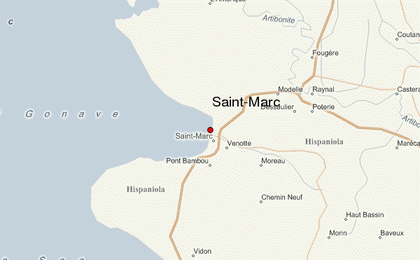
Regional road map
The City of Saint-Marc is located at 19.1049° N, 72.6949° W. According to the IHSI, this commune has a total land area of 556.56 square kilometers (214.89 square miles), of which 401.16 km2 (72%) is suburban, 142.22 km2 (26%) is rural, and 13.18 km2 (2%) is urban. It is bordered on the north by the town of Grande-Saline, on the northeast by the city of Dessalines, on the east by the towns of Liancourt and Verrettes, and on the south by the city of Arcahaie. Saint-Marc has six communal sections which are further subdivided into at least 129 localities and 124 habitations, and a district, Montrouis, which belongs to the 1st communal section of Délugé.
It is positioned in the northern part of a crescent-shaped littoral plain, bounded on the west by the sea and on the east by mountainous landforms that lock it to the south and north; essentially a tableland ringed by mountain ranges. Of the many beaches grazing its coastline, Amani-y Beach remains the most-visited. It is located between the basin of the Artibonite and the Gulf of Gonâve, (entrance to the Bay of Saint-Marc), facing the north side of the Chaîne des Matheux.
The land area of Saint Marc is largely composed of hills and mountains. The climate varies from tropical to cool. This coastal municipality is crossed by the Route Nationale 1. Only 104 kilometers (65 miles) and about about fifty kilometers (31 miles) separate it respectively from Port-au-Prince and Gonaïves.
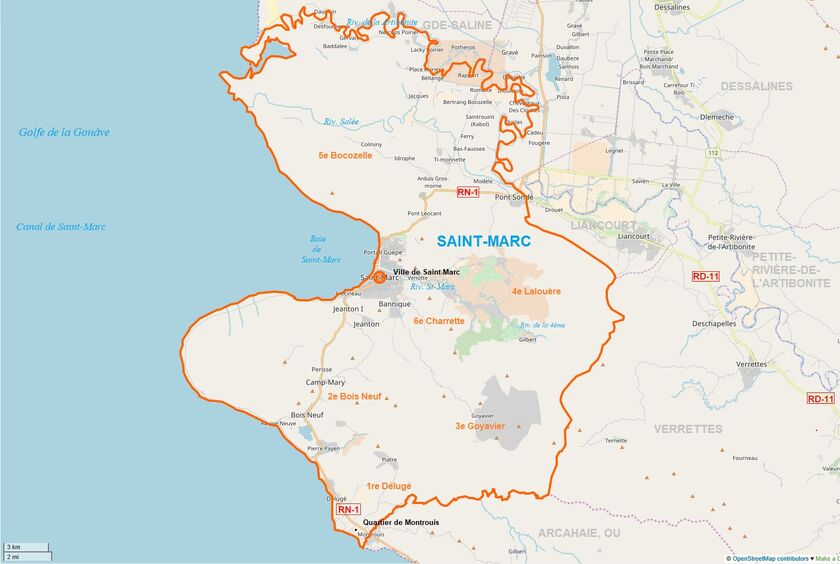
Commune map of Saint-Marc, Haiti
Neighborhoods[]
| SMC | Saint-Marc | 266,642 | |||
|---|---|---|---|---|---|
| VSM | Ville de Saint-Marc | Urban | 149,653 | ||
| QMT | Quartier de Montrouis | Urban | 8,630 | ||
| DLG | 1ère Section Deluge | Rural section | 13,606 | Augier, Bénittier, Beyer, Dauphine, Dégence, Délugé, Duperrier, Etang, Fond-Paul, Grande-Savane, Gresseau, Gressot, Langlois, Lanzac, La Source, Limeau, Montrouis, Piatte, Pinard, Plaine Olive, Raboto, Robert, Vidon | |
| BOF | 2ème Section Bois Neuf | Rural section | 25,940 | Anse Pirogue, Bachette, Banique, Bois Neuf, Bourgeois, Camp Nini, Canelle, Canot, Chadrine, Chapelet, Drouin, Duclos, Fourien, Frecineau, Gardère, Goyavier, Grand-Fond, Jeanton, La Colline, La Coude, La Rochelle, Mare Rosanne, Marie Ti Place, Massambi, Périsse, Pierre-Payen, Platon-Montagne, Risque, Rousseau, Roussette, Sisal, Tamarin, Terre-Noire, Ti Place | |
| GOY | 3ème Section Goyavier | Rural | 10,765 | Ca Day, Coukio, Dogen, Doguen, Fond-Pierrot, Georges Jean, Gilbert, Goyavier, Gros Morne, Janette, Lampré, Morin, Pavajonc, Popotte, Robion | |
| LAL | 4ème Section Lalouère | Rural | 15,712 | Babe, Bel Air, Bellevue, Bimani, Bobe Bertrand, Bois Etienne, Bois l'état, Dipson, Godé, Grand-Fond, Guichamp, Guignon, Henry, Jambon, Janain, La Garème, Laloue, Lamothe, Motaca, Painson, Rassemble, Toman, Viéllot, Villejoint | |
| BZL | 5ème Section Bocozelle | Rural | 32,894 | Acul Basse Terre, Béllange, Bertrand, Bertreng, Bocozel, Boudet ti Place, Camp de l'ODVA, Chauvet, Chevreau-des-Cloches, Colmini, Croix-Mulâtresse, Danache, Deschatelles, Dipson, Duclas, Ferry, Gregoire, Gros-Morne, Grosse-Roche, Guiton, Jacques, L'Amérique, Léocéane, Lubin, Modelle, Molette, Petit-Pothenot, Poirrier, Portail Guepe, Saline des Cotes, Terre Noire | |
| CTT | 6ème Section Charrette | Rural | 9442 | Charette, Dorval, La Vigie, Moreau, Pivert, Pont Bambou, Pont Charriot, Portail Montrouis, Terre Blanche, Venotte, Yousse |
Hydrography
A network of rivers that cross the municipality include the Grande Rivière of Saint-Marc and the Petite Rivière, the Lanzac and Abricot rivers located in the 1st section Délugé, the Freycineau River, and the Artibonite River originating in the Dominican Republic. The Great St. Marc River receives the waters of two tributaries, the Veuve River and the Gobe River.
Demographics
| Year | Population | |
|---|---|---|
| 1896 | 20,000 | |
| 1950 | 53,500 | +168% |
| 1969 | 61,359 | +15% |
| 1982 | 98,189 | +60% |
| 1998 | 154,257 | +57% |
| 2005 | 209,639 | +26% |
| 2009 | 242,485 | +16% |
| 2015 | 266,642 | +10% |
In 2005, the population of the commune of Saint-Marc was estimated at 110,919 women (53%) for 98,720 men (47%). In 2012, the trend of this proportion has been maintained, and the overall estimate became women (52%) for 123,178 men (48%). From this population 162,828 people are aged 18 and over.
Land occupation

Rice fields in a rural section of Saint-Marc, Haiti
Agriculture occupies nearly 40% of the commune's land, rain-fed in the 3rd and 4th sections and irrigated in the 1st, 2nd, 5th and 6th sections. Mountain areas account for 42% of the total area of the municipality and the lowland areas 25%. The plains are mainly covered with banana trees, real trees, coconut palms and avocado trees. Thirdly, the savanna zones (rice zone) occupy 17%. This zone corresponds to the communal section of Bocozelle. In addition to the savannah areas, pastures occupy almost 6%. The forest and agroforestry areas represent respectively 4% and 5% of the total area.
But the most serious of dangers, and by far the biggest, which lurks the city for the next few years, is the reduction of cultivable areas. Concrete leads hard life to farmland. Most of the beautiful and verdant gardens that were once known, (sugar cane fields, bananas, potatoes, maize, etc.) located on the outskirts of the city and beyond it have long been sold, sold or made available to potential buyers for the construction of houses, most often imposing houses, meanwhile, the cultivable areas are dwindling.
Climate

Grosse Roche Beach in Saint-Marc, Haiti
The Municipality of Saint-Marc is in the semi-arid tropical climate zone. These climates tend to have hot, sometimes extremely hot, summers and warm to cool winters, with some to minimal precipitation. Saint-Marc is influenced by the local steppe climate (warm climate found in savannahs and vast plains). In this county, the annual rainfall is insignificant. It is characterized by two major climatic variations: a rainy season extending from April to October (1,300 mm {51 inches} / year) and a dry period from November to March (220 mm {9 inches} / year). The average monthly rainfall is 128 mm {5 inches}. The average annual temperature of the municipality is around 26 degrees Celsius (79* F).
Environmental risks
The commune is practically at risk of flooding in the lowland areas in its northern part. This mainly affects the 5th communal section of Bocozelle. In addition, it enjoys sufficient rainfall, a little more than in the southern part of the municipality. Between 600 and 1400 mm {24 to 55 in.} of rain are expected annually, with all the same average around 700 mm {28 in.} of rain per year. On the other hand, the risk of erosion is variable, by zone, but overall average, and only about three-quarters of the municipal territory.
Economy[]

Streets of Saint-Marc, Haiti
Economically, Saint-Marc is an area of intense activity, without there being, strictly speaking, large enterprises there worthy of this title. These economic activities cover areas as diverse as transport, water, automobile mechanics, food, catering, hotels and entertainment. As a result, there are ten supermarkets and 350 shops, seven hardware stores, twenty car garages, four gas stations (National, Total, Sol, and Easy Gaz), 50 carpentry shops, 55 hairdressing salons, 75 bakeries, five craft enterprises, and 300 restaurants - the most coveted of which are Pivert's two night restaurants: Kay Foun and Villanne-Marie. Furthermore, there are transfer offices (Unitransfert, Western Union, CAM Transfer / Money Gram), commercial banks (Unibank at Rue Surpris-Laurent, Sogebank at Rue Louverture, and the National Bank at the corner of Louverture and Surpris-Laurent), six institutions (SOKOLAVIM, FAHF, SODARME, FINCA, ACME and Capital credit), and many agencies of large local companies involved in various fields (brewery depots BRANA, La Couronne, Sejourné, Tropic S.A, Larco and mobile phone agency Digicel and Natcom).
Of the 24 hotels, the most famous are Club Indigo, Moulin sur Mer, Xaragua, Wahoo Bay, and Kaliko. A good portion of the city's economic activity is carried out in the informal setting.
Commerce is the largest trade in St-Marc. Many find work as a merchant, either with their own stand in the market or at a boutik “convenient store” stand. There are also a multitude of street sellers who carry baskets of goods or candy on their heads, as well as selling canned milk to passers-by. Not many of these products are manufactured in St-Marc.

Residential neighborhood of Saint-Marc, Haiti
Nearly all products sold are received in the country as donations or surpluses from second-hand stores in the U.S. Markets in Saint-Marc are open daily, featuring almost any type of fruit or vegetable grown locally. The city hosts a charcoal market for cooking material. As charcoal is used for much of the cooking, it is manufactured locally and supports a large work force.
Aside from the charcoal market, St-Marc’s economics revolve a great deal around agricultural products produced in the area. In Deye Legliz, an area near St-Marc Harbor, food markets are open daily. Most residents shop on Saturday to stock up on food supplies for the week.
The Boulevard area houses a large flea market, with a variety of mostly second-hand items for sale, from clothing and electronics, to shoes, toys, and bicycles. Many people from Port-au-Prince come to the markets in Saint-Marc because of the inexpensive costs.
Shopping[]

Saint-Marc
Retail brick and mortar (or wooden) stores also exist in Saint-Marc. These include pharmacies, open-air markets, bakeries with wheat and cassava bread and various sweet baked goods, convenience stores, beauty salons, and specialty shops for such items as fabric, hardware, and car parts.
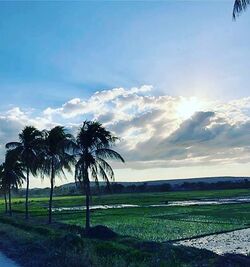
Rice fields in Saint-Marc
Infrastructure[]

Saint-Marc
Transportation
Transportation in Saint-Marc Arrondissement is very efficient. Saint-Marc is located 100 kilometers from Port-au-Prince and 50 kilometers from the city of Gonaïves. They are both linked by Route Nationale 1, which extends all the way up to the coastal towns like Montrouis, before reaching its terminus at the northern port of Cap-Haïtien. The whole city is crossed from north to south by Route Nationale 1, one of the most important roads of the country. This road borrows - in its crossing of Saint-Marc - the main commercial artery of the city, Rue Louverture
The most prevalent mode of transportation is the motorcycle (mobylette), due to the inexpensive maintenance and low gas consumption. Generally, people fit as many as four on a bike even though the mobylettes are designed for a maximum of two people. Bikes are another common source of transport and cars are considered a luxury mode of transportation. Streets are regarded as unsafe for pedestrians, owing to packs of motorcycles and bicycles that clash, significantly reducing the space of individual movement. Moreover, the presence of large trucks and cars, with which the unfortunate pedestrian must share the road, constantly endangers his physical integrity.
St. Marc is known for being a blend of city and rural lifestyles. For many living in Port-au-Prince, it is considered the start of the “country”. Goats are rampant and can be seen roaming about the city streets. Many people in Saint-Marc also own cows or chickens.

Port of Saint-Marc
Port of Saint Marc[]
Like many Haitian cities, Saint-Marc has developed around the port function. The port is open to foreign trade. The wharf is located in the historic center. The port activities and the road traffic that they generate, are in conflict with the urban activities; they even have a negative impact on the urban environment

College Eben-Ezer-de Saint-Marc
Education

Lycee du Bicentennaire de Saint-Marc
The Ministry of National Education of Youth and Sports is represented in the municipality by a school district, led by an inspector. There are approximately 233 schools (preschool, primary, and secondary) and fourteen technical and professional schools.
The Artibonite Department in general has unfavorable access to basic education and Saint-Marc also has a strong deficiency in this area. Many of the better schools teach both French and English as formal languages, resulting in children gaining fluency in those and Creole, their first language.
Health

One of Saint-Marc's clinics
The Artibonite Department is also ranked poorly in terms of health services. Despite the administrative management of the Saint-Nicolas Hospital by a powerful American NGO and the supervision of the dispensaries by the Regional Office of the UCS (Communal Health Unit), Saint-Marc occupies a moderate place and ranks among 12 of the 15 communes of the department. Food insecurity tends to be high, with a prevalence rate that varies between 51% and 60%.
The Ministry of Public Health and Population is represented in the commune by a municipal health office. The city has five hospitals, 24 clinics, two health centers with beds and four health centers without beds, for a total of 35 health facilities. In addition, nearly 47 doctors, sixteen dentists, 57 nurses, 53 auxiliaries, eight laboratory technicians and a radiologist provide the health service at these institutions.
Utilities

Solar pwered buildings, Sain-Marc, Haiti
The municipality's water supply is supported by 39 water points, including 18 rivers, 19 springs, three lagoons, and a pond. Other water points were 22 single boreholes, twelve artesian wells, six valves and two pumps.
As far as electricity is concerned, the urban section and most localities of the municipality are electrified. The Electricity of Haiti (EDH) is responsible for the distribution of electricity in this municipality. The hydroelectric network provides an average of 45 hours of electricity per week.
Although Saint-Marc is not considered an arid region, the availability of running water (or drinking water) is rather precarious in the municipal area. Saint-Marc is not ranked among the 26 communes (out of 133) that have a more or less satisfactory accessibility in running water. Moreover, the high population density has caused an imbalance in the availability of water that even the management assumed by the French-Haitian firm SESAM (Society of Waters of Saint-Marc) can not contain. More than 60% of urban homes, excluding peri-urban areas, are not connected to the current distribution network. Only 20% of the rural population of Saint-Marc consume water from a drinking water supply system (SAEP).
Administration

Saint-Marc City Hall
The municipality of Saint-Marc has a public prosecutor's office, a civil court, three registrars, three peace courts, a police station and two sub-police stations. There is also a prison.
The city is directed by a municipal council of three members including the titular mayor while each of the communal sections is administered by a Council of the Communal Section (CASEC).
According to the Haitian Constitution of 1987 (in force), the municipal council should be assisted by a Municipal Assembly composed of representatives of the Communal Sections. For the Communal Sections, the decisions of the CASECs must be ratified by the ASECs or Assemblies of the communal sections.
The Vice-delegation, formerly called prefecture (until 1986), has its seat in the city and represents the President of the Republic at the county level (the Arrondissement of Saint-Marc; the communes of Saint-Marc, Liancourt, Verrettes and La Chapelle).
Multiple decentralized government departments exist in the municipality such as the General Directorate of Taxation (DGI), the Regional Office of Public Works, Transport and Communications (TPTC), the Regional Office of Electricity of Haiti (EDH), the Office of Communal Agriculture (BAC), the Office of the National Port Authority (APN), the Regional Office of the ONA (National Insurance Office), and the Municipal Library.
SESAM, a private firm, has a monopoly on the exploitation of water in urban space following the law on water reform and through contracts and other concessions granted by DINEPA.
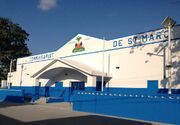
Saint-Marc police station
Culture[]

Saint-Marc
Haitians are a very hospitable and welcoming population, including those in Saint-Marc. It is said here that “Bonjou is the passport”, meaning that saying hello opens doors. Every time you see someone you know or have just met, you must say either “bonjou or bonswa”, literally meaning ‘good day’ or ‘good evening’. Typically the person who enters a room makes the greeting.
Although Saint-Marc is known as the “Pleasure City” as many young people reside here; the majority live in humble settings and work extremely hard to make ends meet.
Saint-Marc residents are so noted for their warmth and hospitality; visitors sometimes perceive them to be angry when they are having ordinary exchanges. This love of life translates into a passion for everything, especially music. If they are voodoo believers, you will most likely find them listening to Haitian folk songs. Otherwise, they prefer Troubadou (which is very similar to salsa music and includes drums, trumpets, and guitar), or American pop music. People in St. Marc enjoy exchanging jokes with each other. Comedy is a favorite pastime.
Religion[]

Cathedrale de Saint-Marc
Approximately 130 churches of various faiths were counted in Saint-Marc including Catholic, Baptist, Adventist, Pentecostal, Church of God, Wesleyan and Jehovah's Witness.

Eglise Baptiste Eben-Ezer de Saint-Marc
Religious believers follow mostly Catholicism and Vodun. Both are prevalent throughout the country. Catholicism/Christianity is the most widespread and generally accepted religion in St-Marc. Most Haitians attend church on Sundays. Roman Catholicism was brought by the French colonists who settled Saint-Domingue; missionary priests and others worked to convert enslaved Africans. Some 80% of Haitians are practicing Catholics, sometimes combining it with elements of Vodun. Evangelical Protestant and Baptist churches are also very common in St-Marc. The majority of residents are very involved in their church as centers of community and cultural identity. On any given day, groups of people singing hymns can also be heard throughout the streets.
Vodun developed from combining of the different West African religions brought by slaves; the word Vodun is derived from an African word meaning spirit. It is more strongly rooted in the rural areas, and this population is more reluctant to accept Western medicine.
Organizations[]
Several non-governmental organizations intervene in the commune of Saint-Marc piloting development actions. According to sources, four political parties, 33 people's organizations, three non-commercial co-operatives, two NGOs, three international organizations, and more than one hundred grassroots community organizations (CBOs) are identified in the commune.

Saint-Marc, Haiti
The Institute of Technology and Animation (ITECA has been supporting the peasant movement in the Matheux region for over 10 years, in partnership with farmers' organizations (mixed and women's) covering six sections (1re Délugé, 2e Bois Neuf, 3e Goyavier, 4e Désarmes, 5e Bastien, and 6e Terre Natte) across two municipalities (Saint-Marc and Verrettes).
ITECA supported two platforms made up of 10 women's organizations in Saint Marc and Verrettes and two mixed platforms made up of 17 organizations, for a total of 3462 members with 1895 women and 369 young people.
Communication
The city of Saint-Marc has fourteen radio stations, a newspaper/magazine and three television stations.
Telephone services are insured by two mobile private telephone companies, Digicel and Natcom.
Leisure[]

Soccer
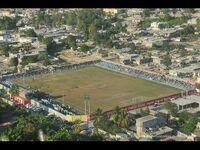
Soccer pitch; Saint-Marc, Haiti
Saint-Marc has many curiosities and attractions, among of which are the historical and archaeological monuments such as Forts Diamant and Blockaus on the northern summit of the mountain (northwest and northeast); the Guillon colonial mill, Gode River Falls, and the cave Voûte à Rober (around the Janin habitation), all in the 4th section, and the Grosse Roche Beach in the north and Amani-y Beach in the south.
Leisure activities in the city include a museum, a theater, three libraries, six cinemas, a football (soccer) pitch, volleyball court, basketball court, tennis court and twelve night clubs, in addition to the gaguères which are 43.

The most popular sports are football (soccer), basketball and volleyball.
Regarding cultural heritage, there are monuments and sites that are colonial, historical and natural. With a rich and eventful history of commerce, the town of Saint-Marc remains an important commune among others and has a place of choice in the history of the country.

Place Philippe Guerrier de Saint-Marc
Music
Popular Haitian groups have developed over the years, such as Les Formidables. This group is no longer together as most members live overseas, but the group’s music lingers in the culture. Virtuose is a very popular group in Saint-Marc. BC and Gwoup 703 are other popular Haitian groups.
RapCreole is an emerging popular style among the youth. Typically this kind of rap uses rhythms typical of Haitian folk or popular music. Popular RapKreyol artists include BC (Barikad Crew), Skwardy, Izolan, and Fantom. Sebastien Pierre is a popular R&B artist.
Zomò is one of the most popular singers of Saint-Marc. In 2014, he featured in a hit called Life goes on, which was one of the best in Haiti.
Food

Food from La Colline Hotel; Saint-Marc, Haiti
If Saint-Marc people love music, they love food as much or more. Food plays a large role in their lives, as meals are an important part of normal daily social interaction. Grown locally, plantains, rice, and pasta are staples of almost every meal. Seafood is also consumed regularly. Crab, dried cod, and varieties of fresh fish are available from coastal waters. For the most part, cooking is done outside to avoid overheating and moisture collection inside. Tastes run from very sweet to spicy seasonings. Local commerce drives the economy of Saint-Marc. A farmers market of new and second-hand wares operates daily, along with produce and meat markets.
Goat is perhaps the most common meat, but chicken and beef are also consumed regularly. Haitians have an affinity for either very spicy food (even peanut butter is spicy) or very sweet food (sugar is added to sugary cereals). Spices and spicy peppers are used abundantly in Haitian cuisine.

Saint-Marc is known for its popcorn
A significant amount of produce is grown locally, specifically bananas, plantains, mangoes, cherries, corn, manioc, rice, and tomatoes. The typical Saint-Marc resident consumes a lot of fruit. A dish very specific to Saint-Marc consists of rice with sauce pois, crab/goat meat mixed in, or both. Other dishes include bananne pesse (fried plaintains) which are accompanied with piklese, a spicy “gardiniera” mixture that consists of carrots, cabbage, and peppers.
Soup is typically prepared on Sunday to make use of all the week's leftovers. It usually consists of several types of meat, potatoes, and carrots. Fresh fish, typically sole, is also consumed regularly. This fish is cooked over an open fire with a mayonnaise-based marinade mixed with various spices.

Sweets in Saint-Marc, Haiti
Riz du lait is a common dessert, essentially a rice pudding made with cinnamon, milk, sugar, and butter. Other Creole-named desserts include dous makos (Haitian fudge), dous kokoye (homemade coconut candy), pen patat (sweet potato bread), and pen diri (rice bread).
Saint-Marc beaches[]

Amani-y Beach in Saint-Marc
Going to the beach is a popular activity for families and friends on the weekend. The most popular time to go is on Sunday after church. The most popular beaches in Saint-Marc are Grosse Roche and Amani-y.
Amani-y beach is a white sandy beach. It was abandoned for more than 25 years before being acquired by the current developer. It is the site of a noted "Zombie hole", a 200-meter-deep reef that features large "Elephant Ear" fan coral, sponge tubes, black coral, blue tang, sea urchins, and many more. Experienced divers have called Amani-y remarkable and unique. On the east end of the beach, walking out to chest-high water brings you to a dramatic drop-off, a wall going down hundreds of meters. At about 120 feet, a series of giant sponges begins. The shallower water is perfect snorkeling for non-divers.
Near the beach are some of the region's noted historical sites, such as the Palace with 365 doors and 52 windows in Petite Rivière de l'Artibonite, the forts in Marchand Dessalines, the pilgrimage site of Saut-d'Eau, and the Port of Saint-Marc.

Saint-Marc, Haiti
Notable citizens[]
Marc Louis Bazin (1932-2010): Politician and former Prime Minister
Clovis Désinor (1914-2001): Politician
Hector Hyppolite (1894-1948): Painter
Antoine Levelt (1910- ): Officer in the army of Haiti. Member of the Military Executive Committee of 1946
Smarck Michel (1937-2012): Politician
Pierre Pinchinat (1746-1804): Deputy representing Saint Domingue in the Assembly of 500
René Piquion (1906 – 2001): Writer, doctor and politician
Nissage Saget (1810-1880): former President of Haiti
Emilcar Simil: painter
Armand Thoby (1841-1899): Politician and author
Saint-Marc Arrondissement: Saint-Marc, La Chapelle, Verrettes, Montrouis, Liancourt
References[]
The City of Saint-Marc and the march of time [1]
Bulletin - Issue 91 [2]
ITECA [3]
Présentation de la Ville de Saint Marc [4]
Arrondissements et Communes: Artibonite [5]
Saint-Marc, Haiti [6]
Ywam, Saint-Marc [7]
Michael Vedrine















